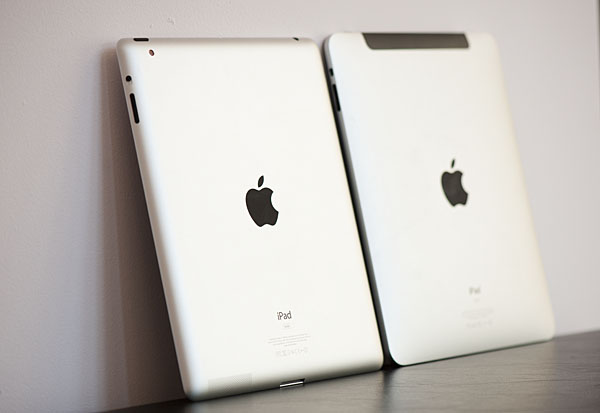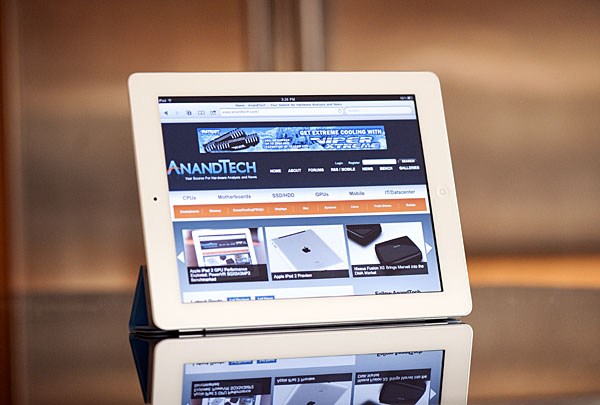The Apple iPad 2 Review
by Brian Klug, Anand Lal Shimpi & Vivek Gowri on March 19, 2011 8:01 PM ESTIndustrial Design & The Future
The original iPad was a device followed by so much hype and anticipation that inevitably, upon launch, it became one of the most polarizing products to launch in the last few years. It also became a huge hit, infusing life into the previously flatlining tablet market, and that's where the iPad 2 comes in.
The industrial design changes are very much in line with what we saw with the 4th generation Apple handhelds. The design language used for the iPhone 3G/3G-S and iPod touch 2G/3G was based on accelerating curvature continuity (known as G3 continuity in industrial design terminology), in contrast to the tangentially continuous design (G1 continuity) found on the original iPhone. What this meant, basically, is that the first iPhone had a relatively flat design, whereas the 3G/3G-S had a gently crowned back that aimed to fit the contour of one's hand.
The original iPad foretold the future of Apple's design language, using a similarly curved back but dumping the blended G3 curvature on the sides for hard edges that met the front face in a perpendicular manner. The iPhone 4 went a step further, with a flat back in addition to the sides. The front profile kept the same rounded corners that every other Apple device has, but the top and side cross-sections end up being rectangles, with all four faces meeting perpendicularly. I'm thinking Apple chose to do this to accomplish two things: being able to use glass for both the front and back faces, as well as to give the iPhone line some separation from the iPod and iPad lines.
The fourth generation iPod touch reaffirmed the notion that Apple was moving back to flatter, more rectangular designs. The use of aluminum instead of glass meant that there wasn't a need for a completely flat back; the predominantly flat back of the iPod tapers to meet the front face at the edges using a short continuous curve.
After seeing the newest iPod touch, I guessed that the second generation iPad would carry rather similar lines. I definitely didn't expect the iPad 2 to be so thin, but overall, it was pretty much in line with what I was expecting.
Another significant aspect to the industrial design changes is the addition of a white-bezeled iPad. The back of both black and white models are the usual anodized aluminum, though the texture of the anodizing on the iPad 2 (as well as the latest MacBook Pros) seems to be a different, smoother one than on previous aluminum Apple devices. Apple seemed to have moved to black bezels on almost all of its products, other than the vaporware-esque white iPhone 4, but between the iPad 2 shipping in white and a promised spring release for the white iPhone 4, it shows that Apple is trending back towards white devices.
The interesting question to ask here is how much we can read into Apple's future designs given the iPad 2, and unfortunately, that isn't a whole lot. It's always difficult to tell with Apple, but it wouldn't surprise me if the iPhone 5 ended up using a very similar design to the iPhone 4. Since the antenna problem is mostly solved (see the antenna diversity on the Verizon iPhone 4), Apple probably doesn't need to do a whole lot to the design for the next generation iPhone. Other than the signal attenuation issues, the iPhone 4 was an amazing piece of hardware, one that Apple spent a lot of money developing. It doesn't make sense for them to turn around and dump it on another ground-up redesign, especially when the 4 is still very competitive from a hardware standpoint. And at this point, I doubt they would focus so much on releasing the white iPhone in spring if they weren't planning on using a very similar chassis for the iPhone 5 that should launch in June.
Given past history, if the iPhone doesn't get a redesign, neither will the iPod touch. Both of the generation 5 handhelds will probably get some form of the A5 SoC, potentially underclocked like the A4 in the iPhone 4. What is more difficult to predict is the 3rd generation iPad. Since we don't really have an established cadence for the iPad, it's hard to say anything about the iPad 3 without reading too much into the iPad 2 launch. I'd say its safe to assume there will be a 6th generation Apple SoC (presumably named the A6), and if I was a betting man, my money would be on at least some form of redesign or at least an ID refresh, but again, with Apple, you really never know.













189 Comments
View All Comments
PeteH - Saturday, March 19, 2011 - link
In the Garage Band section:"There are three Smart Instruments - Piano, Bass, Guitar, and Drums."
I'm pretty sure that "three" should be a "four."
VivekGowri - Sunday, March 20, 2011 - link
Ahaha, I'm an idiot - thanks for catching that, it'll be fixed.PeteH - Sunday, March 20, 2011 - link
As far as typos go that one isn't remotely bad. I once published a spec (internally) that had a section detailing how asynchronous boundaries were handled in my section of a chip. Unfortunately I had titled that section "Cock Domain Crossings."Anand Lal Shimpi - Sunday, March 20, 2011 - link
A few years ago I used the word overcocking instead of overclocking in an article.UNLK A6 - Saturday, March 19, 2011 - link
I'd like some clarification about LINPACK and Geekbench. Are these benchmarks created by compiling some portable code for each platform as a measure of floating point performance? Or, is this supposed to be some measure of how fast one can do linear algebra or DSP on the platform? On Mac OS and iOS, one wouldn't compile say LINPACK for this but use the hand-tuned LAPACK/BLAS and DSP routines built into Apple's Accelerate Framework. The difference between the two can be huge. Which do these benchmarks purport to supply--generic floating point performance or available linear algebra and DSP performance on the platform?metafor - Sunday, March 20, 2011 - link
I believe Linpack on both iOS and Android are plainly compiled (by the JIT in the case of Android) to run on the platform. They don't make any calls against the onboard DSP's nor do they use NEON beyond what the compiler is able to auto-vectorize.name99 - Sunday, March 20, 2011 - link
Apple supplies all the Linpack routines in optimized NEON code as part of the OS (in the Accelerate framework). Intelligent apps that need them use those routines.Android, as far as I know, does not provide an equivalent.
You can use apps that deliberately bypass these iOS routines if you wish to get a handle on the raw FP performance of the hardware, but
(a) it doesn't give actual linear algebra performance, if that is something your app or algorithm really cares about AND
(b) it's kinda dumb because if you care about fp performance in any way, you'll be using NEON, so what's the value in a benchmark that doesn't exercise NEON?
nimus - Sunday, March 20, 2011 - link
I hope AnandTech can do a comprehensive comparison of the usability/feature strengths between the Android, Apple iOS, BlackBerry Tablet OS (QNX), HP webOS, and any others tablet OSes.It will be interesting to see how the Windows Tablet OS will be able to compete when it finally is released for ARM processors.
KidneyBean - Sunday, March 20, 2011 - link
I'm using a tablet, so I can't see the mouse-over pics :-(tcool93 - Sunday, March 20, 2011 - link
I don't know where the reviewer gets the idea Netbooks are much faster. That is nonsense. Here is a video showing an ARM 9 processor being just as fast, yet the ARM 9 processor is running 1/3 the speed of the Netbook Atom. (500mhz vs. 1600mhz for the Netbook).http://www.youtube.com/watch?v=W4W6lVQl3QA&fea...
The Netbook also has a graphics accelerator in it, and the ARM shown in this video doesn't.